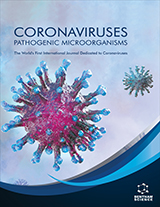Abstract
Background: While the COVID-19 pandemic affected more than thirty million people world-wide, still the true link between COVID-19 and the incidence of stroke remains to be elucidated.
Methods: Herein, we briefly discuss virology of COVID-19 and approaches for diagnosis and treatment of COVID-19 patients, as well as the mechanisms that link stroke and COVID-19. Results: Many pathophysiologic and immunologic mechanisms have been implicated in stroke occurring among patients with COVID-19. COVID-19 pandemic has, in different ways, negative impacts on the care of stroke patients world-wide, and still, neurologists have to face many challenges to improve the care of stroke patients during such crisis. Conclusion: Although the control of the COVID-19 is of crucial importance, at the same time, the management of stroke must not be neglected. Therefore, preserving care for critical conditions such as stroke, and providing strategies to ensure this continues, have a priority even during the crisis. Till vaccine is available for COVID-19, strategies for rapid diagnosis and those for treating patients with that disease are evolving. Further studies are warranted.Keywords: COVID-19, stroke, pathophysiology, outcomes, stroke and COVID, SARS-CoV, COVID virology.
Coronaviruses
Title:Stroke and COVID-19 Pandemic: The Dilemma
Volume: 2 Issue: 8
Author(s): Sherif Mohamed*, Seham Abd El-Mohsen, Osama Abo El-Hassan, Azza AbdelHaffez and Nashwa Abd El-Aziz
Affiliation:
- Department of Chest Diseases and Tuberculosis, Faculty of Medicine, Assiut University, Assiut,Egypt
Keywords: COVID-19, stroke, pathophysiology, outcomes, stroke and COVID, SARS-CoV, COVID virology.
Abstract: Background: While the COVID-19 pandemic affected more than thirty million people world-wide, still the true link between COVID-19 and the incidence of stroke remains to be elucidated.
Methods: Herein, we briefly discuss virology of COVID-19 and approaches for diagnosis and treatment of COVID-19 patients, as well as the mechanisms that link stroke and COVID-19. Results: Many pathophysiologic and immunologic mechanisms have been implicated in stroke occurring among patients with COVID-19. COVID-19 pandemic has, in different ways, negative impacts on the care of stroke patients world-wide, and still, neurologists have to face many challenges to improve the care of stroke patients during such crisis. Conclusion: Although the control of the COVID-19 is of crucial importance, at the same time, the management of stroke must not be neglected. Therefore, preserving care for critical conditions such as stroke, and providing strategies to ensure this continues, have a priority even during the crisis. Till vaccine is available for COVID-19, strategies for rapid diagnosis and those for treating patients with that disease are evolving. Further studies are warranted.Export Options
About this article
Cite this article as:
Mohamed Sherif *, El-Mohsen Abd Seham , El-Hassan Abo Osama, AbdelHaffez Azza and El-Aziz Abd Nashwa , Stroke and COVID-19 Pandemic: The Dilemma, Coronaviruses 2021; 2 (8) : e260721189969 . https://dx.doi.org/10.2174/2666796701666210106112342
| DOI https://dx.doi.org/10.2174/2666796701666210106112342 |
Print ISSN 2666-7967 |
| Publisher Name Bentham Science Publisher |
Online ISSN 2666-7975 |
 51
51
- Author Guidelines
- Graphical Abstracts
- Fabricating and Stating False Information
- Research Misconduct
- Post Publication Discussions and Corrections
- Publishing Ethics and Rectitude
- Increase Visibility of Your Article
- Archiving Policies
- Peer Review Workflow
- Order Your Article Before Print
- Promote Your Article
- Manuscript Transfer Facility
- Editorial Policies
- Allegations from Whistleblowers
- Announcements
Related Articles
-
Infective Endocarditis Complicating Hypertrophic Obstructive Cardiomyopathy: Is Antibiotic Prophylaxis Really Unnecessary?
Current Cardiology Reviews Systemic Sclerosis: Clinical Manifestations
Current Rheumatology Reviews Update on the Adverse Effects of Clozapine: Focus on Myocarditis
Current Drug Safety Chest Radiograph (CXR) Manifestations of the Novel Coronavirus Disease 2019 (COVID-19): A Mini-review
Current Medical Imaging Can Chest Computed Tomography Findings of Symptomatic COVID-19 Patients Upon Admission Indicate Disease Prognosis and Clinical Outcome?
Current Medical Imaging Transient Abnormal Myelopoiesis in Down’s Syndrome - A Diagnostic Dilemma
Applied Clinical Research, Clinical Trials and Regulatory Affairs AIDS-Related Kaposis Sarcoma: State of the Art and Therapeutic Strategies
Current HIV Research Aortic Dissection: A Review of the Pathophysiology, Management and Prospective Advances
Current Cardiology Reviews Tyrosine Kinase Inhibitors – A Review on Pharmacology, Metabolism and Side Effects
Current Drug Metabolism Spontaneous Biliary Pericardial Tamponade: A Case Report and Literature Review
Current Cardiology Reviews Imaging Features of Thoracic Manifestations of Behçet’s Disease: Beyond Pulmonary Artery Involvement
Current Medical Imaging Pearls from the First Gulf Cardiac Amyloidosis Summit 2021
New Emirates Medical Journal Descending Necrotizing Mediastinitis: Current Strategies for Diagnosis and Treatment
Current Respiratory Medicine Reviews Deep Neck Infections: Decisional Algorithm for Patients with Multiple Spaces Involvement
Reviews on Recent Clinical Trials Angiotensin Converting Enzyme Inhibitors and Angiotensin II Receptor Antagonists in Experimental Myocarditis
Current Pharmaceutical Design Tuberculous Pericarditis
Current Cardiology Reviews Cryoballoon Ablation of Atrial Fibrillation: State of the Art 10 Years After Its Invention
Recent Patents on Cardiovascular Drug Discovery Cardiovascular Aspect of Beta-Thalassaemia
Cardiovascular & Hematological Agents in Medicinal Chemistry Heart Failure in Sub-Saharan Africa
Current Cardiology Reviews Micro- and Macrovascular Treatment Targets in Scleroderma Heart Disease
Current Pharmaceutical Design



























